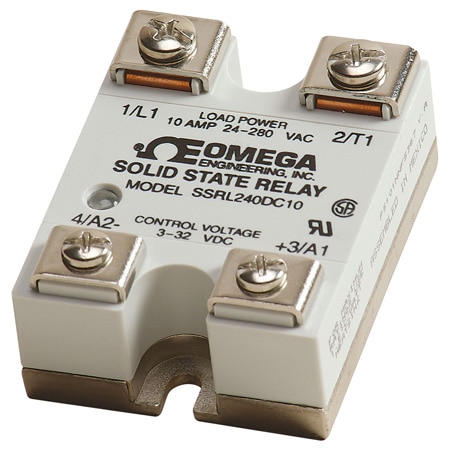Call us at 1-888-826-6342

| Quantity | Price each |
|---|---|
| 1-9 | $36.62 |
| 10-24 | $34.79 |
| 25-49 | $34.06 |
| 50-99 | $32.59 |
| 100-199 | $31.86 |
| 200+ | $31.13 |
Edit these specs to order a different model. Not all combinations are valid. Options compatible with previous selections will be in bold.
*Highlighted options are not compatible. Please select a different combination.
| Specifications | 10 Amp | 25 Amp | 50 Amp | 75 Amp | 100 Amp |
| Max On State Current | 10 A | 25 A | 50 A | 75 A | 100 A |
| Max On State Current | 100 mA | ||||
| Max 1-Cycle Surge | 150 A | 300 A | 750 A | 1000 A | 1200 A |
| Max 1 sec Surge | 30 A | 75 A | 150 A | 225 A | 300 A |
| 12T (60 Hz), A2sec | 416 | 937 | 2458 | 5000 | 6000 |
| Input-Control Signal | Output | |||||
| Model No. | Type | Control Signal Voltage | Control Signal Turn-On | Control Signal Turn-Off | Max Input Current | Peak Voltage* (60 Sec. Max.) |
| SSRL240AC10 SSRL240AC25 SSRL240AC50 SSRL240AC75 SSRL240AC100 | ac Control Signal | 90 to 280 Vac | 90 Vac | 10 Vac | 10 mA | 800 V |
| SSRL240DC10 SSRL240DC25 SSRL240DC50 SSRL240DC75 SSRL240DC100 | dc Control Signal | 3 to 32 Vdc | 3 Vdc | 1 Vdc | 14 mA | 800 V |
| SSRL660AC50 SSRL660AC75 SSRL660AC100 | ac Control Signal | 90 to 280 Vac | 90 Vac | 10 Vac | 10 mA | 1200 V |
| SSRL660DC50 SSRL660DC75 SSRL660DC100 | dc Control Signal | 4 to 32 Vdc | 4 Vdc | 1 Vdc | 14 mA | 1200 V |
| Model No. | Nominal ac Line Voltage | Nominal Load Current | Max. Contact Voltage Drop | Max. Off-State Leakage (25°C max. ambient) | ||
| 120 Vac | 240 Vac | 440 Vac | ||||
| SSRL240AC10 SSRL240AC25 SSRL240AC50 SSRL240AC75 SSRL240AC100 | 24 to 280 Vac | 10 A 25 A 50 A 75 A 100 A | 1.6 V | 0.1 mA | 0.1 mA | N/A |
| SSRL240DC10 SSRL240DC25 SSRL240DC50 SSRL240DC75 SSRL240DC100 | 24 to 280 Vac | 10 A 25 A 50 A 75 A 100 A | 1.6 V | 0.1 mA | 0.1 mA | N/A |
| SSRL660AC50 SSRL660AC75 SSRL660AC100 | 48 to 660 Vac | 50 A 75 A 100A | 1.6 V | 0.25 mA | 0.25 mA | 0.25 mA |
| SSRL660DC50 SSRL660DC75 SSRL660DC100 | 48 to 660 Vac | 50 A 75 A 100 A | 1.6 V | 0.25 mA | 0.25 mA | 0.25 mA |